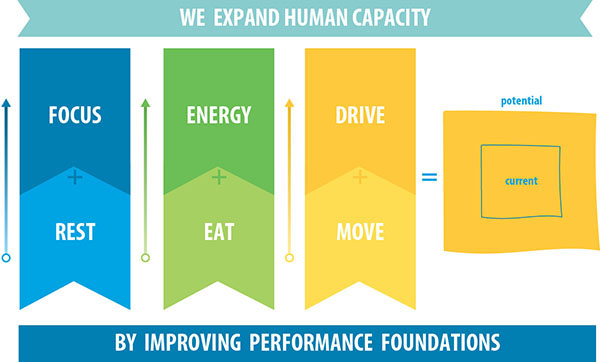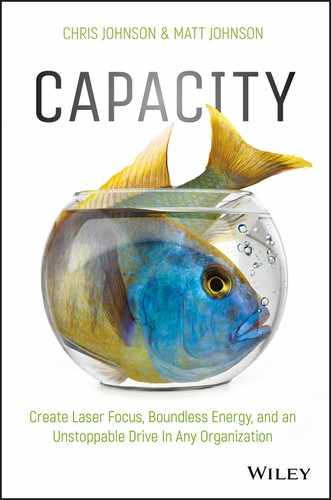12
Why Not?
Almost everything you read about being your best or creating the most amazing organizational culture begins and ends with finding your purpose, or what we call your why. Finding your why can be very powerful. However, there may be a consideration besides finding your why that triggers more action, that may guide you faster to where you should go. Have you ever asked yourself, why not?
Jim Collins, in his game-changing book Good to Great, ignited a tremendous paradigm shift when he redefined every organization’s most valuable asset (its people). The analogy he used to personify this movement was filling up the bus (company/organization) with the right people and placing them in the right seats. His point was that your people are the most important part of your organization, and you need to build a process that finds and places the best people in the correct spot inside your organization.
Over the past 20 years since Good to Great came out, organizations and leaders have spent billions and billions of dollars recruiting, retaining, and evaluating their talent. Departments, committees, head hunters, managers, and corporate culture wizards have mastered this art. But is it enough for the future to just find and place the right people in the right seats? Does this talent need anything else? According to a 2017 Deloitte Human Capital Study “Rewriting the rules for the digital age,”1 the past 20 years has yielded the worst increase in productivity in a very long time, yet technology is advancing at a vertical rate.
Jim Collins’s principles will hold true to the test of time: Your people are the most valuable asset in your organization; continue to invest and refine your process to attract and retain talent. Where you have the biggest opportunity to differentiate yourself is by asking, “What is the most valuable asset to my people?” As you read in Chapter 2, your people’s most valuable asset is their health. After you attract the right talent and place them in the right seats, your next thought should be, “How do I invest in this asset? What type of investment will give us and them the biggest return?” What we have unlocked over the last 10 years is that not only will the investment work for your current people, but when you invest in people where they need and want to be invested, you begin to attract and retain desirable recruits, and build the most unstoppable culture to fulfill the organizational purpose.
So, instead of asking, “Why should we build our people’s capacity?” ask, “Why not build our people’s capacity?” We all know our demands are increasing, so don’t just rely on talent to handle drinking from the firehouse.
Oxygen Mask
It’s hard not to roll your eyes and completely tune out during every airline safety demonstration. It’s all common sense for the most part, right? Don’t smoke in the lavatory. Make sure your tray tables are locked and your carry-on is stowed away during takeoff. If the oxygen masks are deployed due to loss of cabin air pressure, make sure to secure yours before helping others. That one always seemed second nature to us. Shouldn’t people instinctively ensure their own safety and well-being before helping one another? That is a good analogy to explain the process of expanding your personal capacity and that of your organization. Put putting your own oxygen mask on first. The only difference is that, when it comes to capacity, there are a lot of other options.
When we travel and hear the message about putting the oxygen mask on before helping others, it makes us think, “Why don’t people invest in themselves first? Why don’t organizations see this urgency?” We all want to make an impact, help others, and be successful, but if we don’t build our own capacity first, we are sacrificing the true potential to make a difference and to help others.
Focus, energy, and drive are the oxygen of your organization (Figure 12.1). If you laid out all your goals, projects, and initiatives and asked, “What will we need from our people to crush these goals?” you will most likely come back to these three performance outcomes. Is it possible to be creative without focus? Can you make the sales and close the deals without energy? If you are trying to innovate, create, or adapt, will you have more drive than your competition? In our fast-paced, cutthroat world it is easy to get caught up in the external noise, but if you truly want to help others and build the most amazing business, start by putting on the oxygen mask.

FIGURE 12.1 The Capacity Process.
We Should All Be More Productive
In the age of instant access to everything all the time, shouldn’t we be seeing record productivity? Smartphones, machine learning, and the advent of self-driving cars are just a few of the mind-blowing innovations that are marketed as productivity enhancers. These technological advances certainly create exciting opportunities for us, but they also enable us to create a vicious cycle of completion instead of capacity expansion. The Deloitte study highlights an alarming realization: We are not evolving like we could or should.
We talked about success in Chapter 1—everyone wants success. The area or specifics of success vary, but the drive to succeed is in all of us. It could be business, art, athletics, parenthood, friendship, philanthropy, economics, or anything you want. The true key to this success is productivity. Most believe productivity is to complete or to finish. We tell ourselves, “I was productive today. I got 10 things done, picked up the kids, made dinner, and washed the dog.” What productivity really means is the state of or quality of being productive. In the burning desire to be successful, we are prioritizing finishing or completing; let’s reprioritize quality. It is easy to create a to-do list and just check it off and think we are productive. In this hyperconnected superficial world, we should strive to be the best. When you think of success and productivity from now on, think about doing what you were meant to do with extreme quality. Over the course of this book we have given you the blueprint to expanding your capacity; this blueprint will take everything or anything you are doing and make it better so you can produce the quality that you are meant to.
Slack, smartphones, A/I, drivable cars, and so on are thought to be productivity enhancers. None of these affect the quality of your success. These are efficiency tools, meant to help make life more streamlined so you can focus on producing. What we have seen is the reliance on technology for our productivity, but the ignorance of building our own capacity first.
You could build a house in a couple days; people are probably trying. This is not a statement of productivity; this is a statement of speed, quickness, and efficiency. Today we are completing more and more, and organizations are getting a lot of things done. But we are not doing it with the utmost quality we could have, or productivity that we should require from ourselves.
If life were perfect, this book wouldn’t matter that much. Imagine if life were like that game where you must organize the shapes to fit into a square box. It’s easy when you remove the pieces one by one and know exactly which piece goes where. But the game is impossible or feels impossible when you get one of those pieces in the wrong spot; the constraints of the size limit your ability to change course or pivot while you are doing it. This is life: It is easy when the pieces fall into place, and the reality is that you really don’t have to grow or change much when everything fits perfectly. As you already know, we are becoming more and more restrictive in our life because of the demands we have. Up until this point many people have learned only to prioritize or manage their puzzle pieces. But we are telling you there is a different way, a better way. We want to show you how much easier it is if you have 10 different ways and a lot more room to fit each piece. That is what building your capacity does: It allows you to grow to make the right move; it allows you to be resilient to whatever curve ball comes your way. You can build your foundation so strong that when you need it you have the range to go right, left, up, or down.
We are on a mission to help 10 million people build their capacity, because a world where people reach their true potential is in our opinion what true abundance is meant to look like.
How do you measure your organization’s capacity?
Capacity Index
There are three key metrics that when combined evaluate how much capacity your organization has.
- Engagement: There are equations that evaluate how much cost and productivity an engaged employee has verses a disengaged employee.
- Health-Care Costs: There is no denying that a healthy employee is a better employee. When you have employees that are heavily medicated, are overweight, and have chronic medical conditions, it doesn't only impact your bottom line; it also impacts their performance.
- Profitability: We understand that not all organizations are for profit, but this is the best connector for evaluating capacity. If there is room to improve engagement and decrease healthcare costs, it is certain that you are missing out on profits.
Look at a sample of what happens when your people have more capacity. These numbers come from the same organization:
Employees: 5,000
Revenue: $6 billion
Limited Capacity
Engagement Level: 28 percent
Health-Care Costs: $12,000/per employee ($60 million)
Profitability: 32 percent
Expanded Capacity
Engagement Level: 35 percent
Health-Care Costs: $9,600/per employee ($48 million)
Profitability 37 percent
